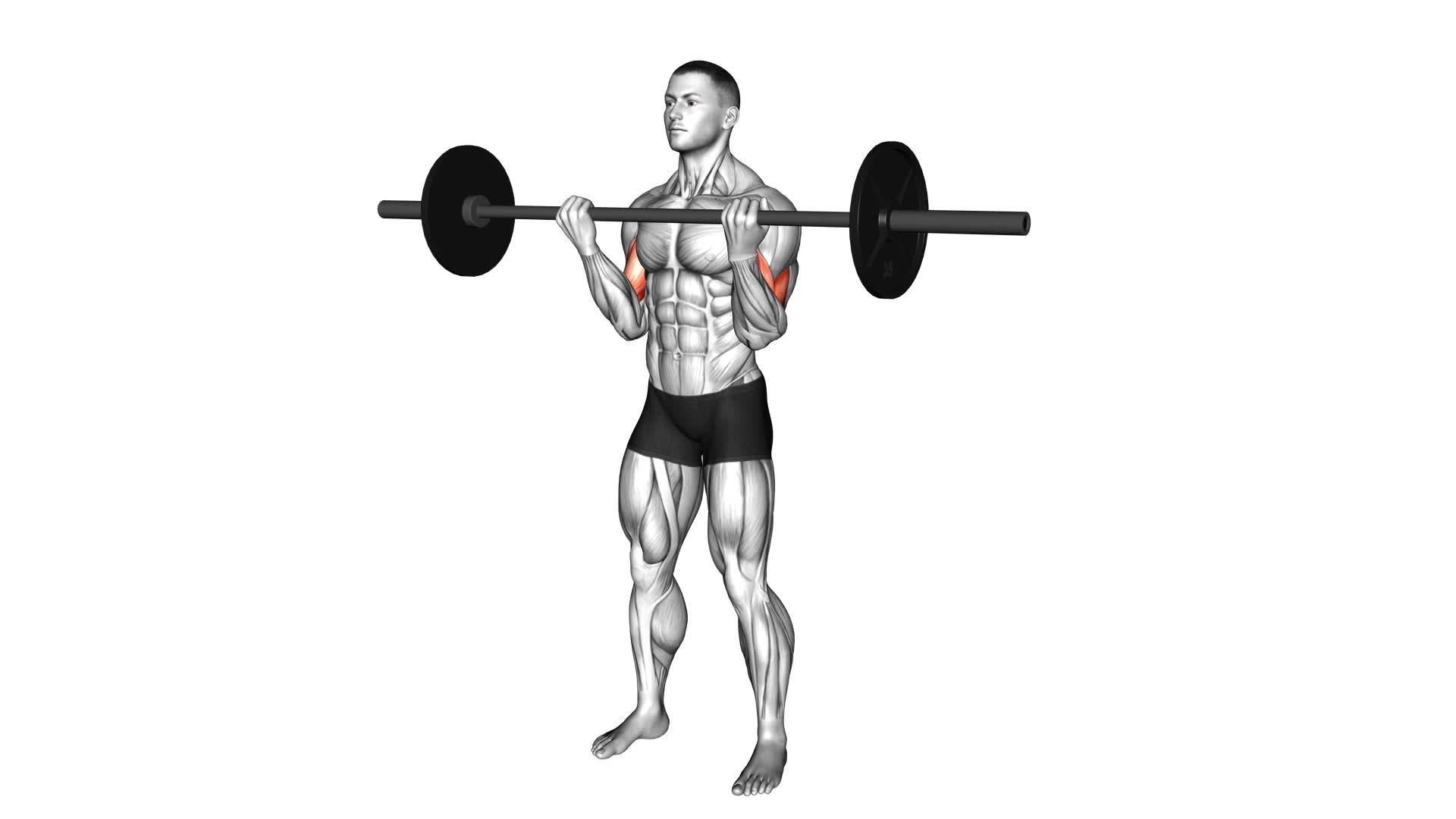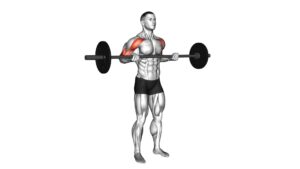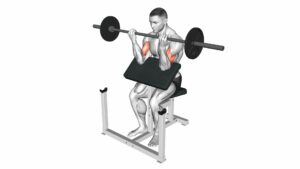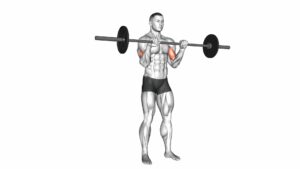Barbell Curl – Video Exercise Guide & Tips

Feeling like your bicep workouts are getting stale and unproductive? Fact is, the Barbell Curl is a powerhouse exercise that can seriously ramp up your bicep training. This article offers a comprehensive guide packed with tips on mastering various versions of this core muscle-building workout including standing barbell curls, seated curls and more.
Watch This Exercise Video
Let’s dive in and reshape those arm workouts for maximum results!
Key Takeaways
- Barbell curls are a powerful exercise for building and strengthening your biceps.
- The exercise primarily targets the bicep muscles but also engages other muscles in the upper arm.
- Proper form and technique, such as keeping elbows close to the body and avoiding swinging motions, is crucial for maximizing results with barbell curls.
- Variations of barbell curls, like preacher curls, hammer curls, and EZ barbell curls, provide different ways to target and strengthen your arms.
What is the Barbell Curl Exercise?
The Barbell Curl Exercise is a weightlifting exercise that targets the biceps muscles and helps to build strength and definition in the arms.
Benefits for biceps
Engaging in barbell curls primarily primes your biceps for tremendous growth and strength. This exercise isolates the upper arm’s muscle, making it work harder, thus enhancing its shape and size over time.
Moreover, consistent training with barbell curls promotes greater muscular endurance in your biceps. Increasing the weight gradually facilitates continuous progress. Enhanced bicep muscles don’t just offer you a more impressive physique; they also improve your overall arm mobility and reduce the risk of injury during physical activities or sports that require heavy lifting or sudden arm movements.
Muscles targeted
The barbell curl exercise primarily targets the biceps, which are located in the front of the upper arm. This exercise helps to develop and strengthen the bicep muscles, giving them a more defined and sculpted appearance.
In addition to working the biceps, the barbell curl also engages other muscles as secondary movers, including the brachialis and brachioradialis muscles. These muscles assist in bending and extending the elbow joint during the movement.
By incorporating barbell curls into your workout routine, you can effectively target and strengthen these key muscle groups for improved upper body strength and aesthetics.
How to Perform the Wide Grip Standing Barbell Curl
To perform the wide grip standing barbell curl, start by standing with your feet shoulder-width apart and gripping the barbell with an overhand grip that is wider than shoulder width.
Proper form and technique
To perform the barbell curl with proper form and technique, start by standing with your feet shoulder-width apart and gripping the barbell with an underhand grip. Keep your elbows close to your sides and slowly curl the barbell upward towards your chest while keeping your upper arms stationary.
Pause for a moment at the top of the movement, then slowly lower the barbell back down to starting position. Make sure to engage your biceps throughout the entire exercise and avoid using momentum or swinging motions.
Focus on controlled movements for maximum results.
Related tips for maximum results
To get the most out of your barbell curl workouts, there are a few tips you should keep in mind. First off, make sure to maintain proper form throughout the exercise. This means keeping your back straight, shoulders relaxed, and elbows close to your body.
Additionally, it’s important to use a weight that challenges you but allows you to perform the exercise with correct technique. Don’t forget to engage your biceps fully by squeezing them at the top of each curl.
And finally, be consistent with your training by incorporating barbell curls into your overall arm workout routine. These tips will help you maximize your results and build stronger biceps over time.
Seated Barbell Curl: Video Exercise Guide & Tips
In this section, we will provide instruction and tips on how to properly perform the seated barbell curl exercise for maximum results.
Instructions for performing the exercise
To properly perform the barbell curl exercise, start by standing shoulder-width apart with your feet firmly planted on the ground. Hold the barbell with a wide grip, palms facing forward.
Keep your back straight and core engaged throughout the movement. Slowly lift the barbell towards your shoulders while keeping your elbows stationary. Squeeze your biceps at the top of the movement and then slowly lower it back down to starting position.
Repeat for the desired number of repetitions, focusing on maintaining proper form and control throughout each rep.
Correct technique for maximum results
To achieve maximum results with the seated barbell curl, proper technique is crucial. Start by sitting on a bench with your feet flat on the floor and shoulder-width apart. Grasp the barbell with an underhand grip, keeping your hands slightly wider than shoulder width apart.
Keep your upper arms stationary and curl the barbell upwards towards your shoulders, without swinging or using momentum. Contract your biceps at the top of the movement and then slowly lower the weight back down to starting position.
Maintain control throughout the exercise and avoid using excessive weights that compromise form. By following these correct techniques, you can maximize muscle recruitment in your biceps and ensure optimal results from this exercise.
Variations of Barbell Curl
Some variations of the Barbell Curl include the Preacher Curl, Hammer Curl, and EZ Barbell Curl.
Preacher Curl
The preacher curl is a variation of the barbell curl that specifically targets the biceps muscles. To perform this exercise, sit on a preacher bench with your chest pressed against the pad and hold a barbell with an underhand grip.
Keeping your upper arms stationary, exhale as you curl the barbell up towards your shoulders, contracting your biceps at the top. Inhale as you slowly lower the weight back down to starting position.
This exercise isolates and works the biceps effectively, helping to increase their size and strength.
To maximize results during preacher curls, it’s important to maintain proper form and technique throughout each repetition. Make sure to keep your elbows tucked in close to your body, avoid using momentum or swinging motions, and focus on squeezing your biceps at the top of each rep.
Hammer Curl
The hammer curl is a variation of the traditional bicep curl that specifically targets the brachialis muscle in addition to the biceps. To perform this exercise, stand with your feet shoulder-width apart and hold a dumbbell in each hand with your palms facing inward.
Keeping your elbows close to your sides, slowly lift the dumbbells toward your shoulders while maintaining a neutral grip throughout the movement. Pause briefly at the top before slowly lowering them back down to starting position.
This exercise helps build overall arm strength and can be incorporated into your upper body training routine for maximum results.
EZ Barbell Curl
To perform the EZ Barbell Curl, start by gripping the EZ bar with an underhand grip, hands slightly closer than shoulder-width apart. Stand up straight with your feet hip-width apart and arms fully extended down in front of you.
Keeping your upper arms stationary, curl the barbell towards your chest while contracting your biceps. Pause briefly at the top of the movement and then slowly lower the weight back to the starting position.
The EZ Barbell Curl is a great variation of the traditional barbell curl that provides added comfort for your wrists and reduces strain on your forearms.
Conclusion
In conclusion, the Barbell Curl is a highly effective exercise for targeting and building your biceps. By following proper form and technique, you can maximize results and achieve stronger, more defined arms.
Check out our video guide and tips to ensure you’re performing the Barbell Curl correctly for optimal gains.
FAQs
1. What is the Barbell Curl video exercise guide?
The Barbell Curl video exercise guide (003112) is a resource that shows correct techniques for barbell curl exercises and variations like Incline Dumbbell Curl and Reverse Barbell curl.
2. How can I effectively train my inner biceps with this guide?
Through the wide grip curl instruction in the video, you’re able to focus more on your inner bicep training leading to maximum results for barbell curls.
3. Can I learn other types of curls from this guide?
Yes! The Barbel Curl Video Guide also displays different dumbbell curl variations like Concentration Curl, Hammer Curl Technique, and EZ Bar Curls.
4. How will learning correct technique for barbell curl benefit me?
Learning correct technique using our Standing Curl Instruction Video ensures muscles worked during a routine include targeted areas hence reducing injury risks.
5. Are there any alternatives shown if I don’t have access to a barbell?
Absolutely! This comprehensive exercise guide includes directions on performing similar movements using dumbbells as an alternative allowing flexibility when equipment availability varies.

Author
Years ago, the spark of my life’s passion ignited in my mind the moment I stepped into the local gym for the first time. The inaugural bead of perspiration, the initial endeavor, the very first surge of endorphins, and a sense of pride that washed over me post-workout marked the beginning of my deep-seated interest in strength sports, fitness, and sports nutrition. This very curiosity blossomed rapidly into a profound fascination, propelling me to earn a Master’s degree in Physical Education from the Academy of Physical Education in Krakow, followed by a Sports Manager diploma from the Jagiellonian University. My journey of growth led me to gain more specialized qualifications, such as being a certified personal trainer with a focus on sports dietetics, a lifeguard, and an instructor for wellness and corrective gymnastics. Theoretical knowledge paired seamlessly with practical experience, reinforcing my belief that the transformation of individuals under my guidance was also a reflection of my personal growth. This belief holds true even today. Each day, I strive to push the boundaries and explore new realms. These realms gently elevate me to greater heights. The unique combination of passion for my field and the continuous quest for growth fuels my drive to break new ground.







